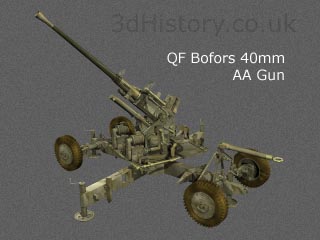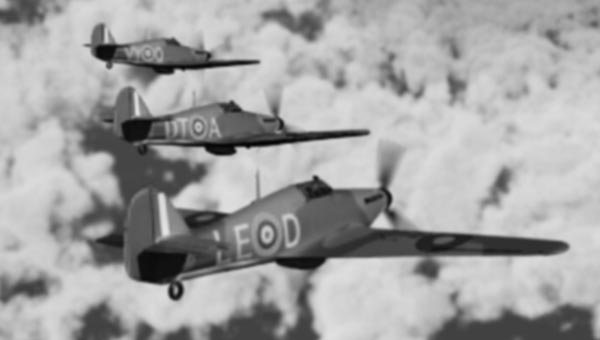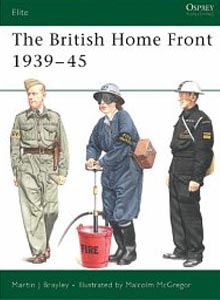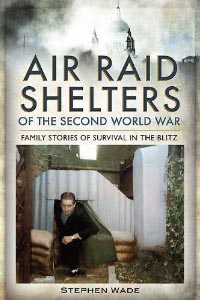The Second World War - Defences - World War Two - The Blitz
The Blitz - Home Defences
Air Raid Warning
When the Observer Corps or Radar detected a raid the information was passed down to the local authority who sounded the air raid warning. The alert was a load siren that made a sound that rose and fell in pitch. When it was sounded people had to find shelter. Not every alert ended in a raid and sometimes there was a raid without any warning. When the alert was over the All Clear was sounded, which was a long continuous sound from the sirens.
Anti aircraft guns
Anti aircraft guns were located at key points on the paths the enemy bombers were expected to travel or around important targets. They would fire high explosive shells up into the air at the attacking aircraft. At a certain height a fuse would explode the shell spreading a cloud of steel fragments called shrapnel through the air that would hopefully hit an aeroplane.
| There were many different types and sizes of guns. Some were small rapid firing guns that were intended to defend against low flying aircraft. Some, like the 40mm Bofors gun, were intended to defend against high flying bombers and had a simple mechanical device that could predict where to aim the gun based on the speed and altitude of the target. |
 |
Search Lights
During the Blitz most attacks took place a night and Bombers were hard to find. Powerful searchlights were used to illuminate the bombers so that the anti-aircraft gunners could target them.
Fighters
Fighters were the best defense against enemy attacks. The RAF had two very modern fighters at their disposal in the Supermarine Spitfire and Hawker Hurricane. The Fighters could be directed to the enemy aircraft by Controllers based in operations rooms. This saved vital time and fuel and allowed the RAF to co-ordinate attacks on the bomber streams between the various squadrons involved.

The Hawker Hurricane was the most numerous British fighter during the Battle of Britain and the Blitz
Barrage Balloons
Barrage Balloons were used to make the bombers fly higher. This made their aim less accurate and made it easier for the anti-aircraft guns to target them. Each balloon was anchored to the ground by a steel cable. If an aircraft flew into to the cable it dragged the balloon down and exploded a mine that could be attached to the balloon. There were almost 1,500 balloons protecting important industrial centres, of which around 500 were deployed in London.
RDF (Radar)
Radio Detection Finding (RDF or Radar) allows the detection of aircraft at long range. It works by transmitting radio beams and collecting those that are reflected back off the aircraft. Before the war the RAF had spent a lot of time and effort into setting up two Radar networks around Britain. One, called Chain home Low, detected low flying aircraft at short range and the other, called Chain Home, detected high flying aircraft at long range. RDF gave the RAF a very distinct advantage during the Battle of Britain and the Blitz. Standing patrols were not necessary allowing the RAF to conserve its resources. RDF operators could often distinguish between bomber and fighter formations; this allowed the RAF to commit forces only against bombers and avoid unnecessary engagements with fighter swarms intended to destroy RAF aircraft. Fighters were only launched when an attack was on its way and they were directed straight to the attacking bombers making it much easier to find them.
Royal Observer CorpsThe Royal Observer Corps was a civilian organisation that operated a Raid Reporting System from a network of observation posts. The Observer Corps used high powered binoculars to identify enemy formations and reported them back to a control centre by telephone. This, along with RDF (radar), gave the RAF a great advantage when planning their defensive moves. BlackoutThe Blackout started on the 1st of September 1939, the day that Germany invaded Poland, two days before Britain and France declared war on Germany. The Blackout was intended to prevent any light from the ground helping the German bombers identify their targets. Everyone had to cover their doors and windows with blinds, heavy blackout curtains or paint. . |
 Osprey - The British Home Front |
Vehicles had covers fitted over the headlights with a slit in
them to direct the light downwards. Street lights and other sources
of light were turned off. The Blackout was responsible for thousands
of civilian deaths because it was very difficult to see traffic
approaching in the dark
Air Raid Shelters
During an air raid people would try to take shelter in a secure place. The government provided public shelters in the cities and people were provided with their own for use at home. Surface shelters were soon found to offer limited protection and in London people started to use the Underground Railway stations as shelters, sleeping on platforms and corridors, often throughout the night.
| Anderson shelters were made
from corrugated sheets of iron that were bolted together to
form an arched room that could be partially buried in the
garden. They were cold and damp and people disliked using
them. Nevertheless over one and half million Anderson
shelters had been erected by the end of September 1939. In 1941 the Morrison Shelter, named after the Minister for Home Security, Mr. Herbert Morrison, was introduced. The Morrison Shelter was basically a big cage, approximately 2m ( 6.5ft) long by 1.2m (4ft) wide by 0.75m (2.5 ft) high, that could be installed inside the home, providing some protection against falling rubble. |
 Air Raid Shelters |
